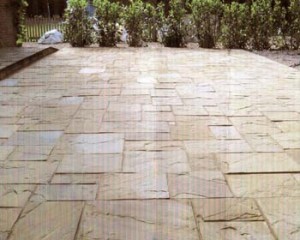 What will the paving be used for?
What will the paving be used for?
There are a few things to think about first before laying yorkstone paving. If you are planning to drive vehicles on the paved area then the paving slabs should be thicker (at least 75mm) and you will need a thicker sub-base. For pedestrian traffic thinner slabs will be fine and a layer of bedding without a sub-base at all will normally be fine. Plan the area to be covered and calculate the number of paving slabs you will need. Sawn slabs of a fixed size (e.g. 600mm x 300mm) are easier to plan for than riven slabs of random width.
Laying riven paving
If the paving slabs are riven it is likely that the thickness of each slab will vary slightly as each slab of riven yorkstone is unique. Riven yorkstone slabs are often supplied as random-sized pieces. If you are using random slabs you may be better to the lay the slabs out first numbering them as you go along. You don’t want any small gaps when you have laid them on the bedding or you may have to pull them back up. If the paving slabs are gauged both ways (all the same size) this is the easiest of the paving types to lay. If the paving slabs are gauged one way it will make it slightly easier but random by random paving slabs are the hardest of the paving types to lay because a lot more planning will be needed. It is also more important with riven paving to lay the slabs the right way up. The top surface should have neat square edges while the underside will have less clearly defined edges.
Take care!
Yorkstone paving slabs are very heavy so extra care should be taken when laying the slabs. It is easy to hurt your back if you are not used to working with heavy stone slabs.
Laying the bedding
For driveways and other areas with vehicles you will need a solid sub-base made up of rubble or crushed stone and impacted down with a whacker plate or roller. Using a soft sub base can be disastrous as it will more than likely start to sink when the heavy paving slabs are laid. You should also consider using a concrete sub base of 75-100mm if the paved area will be heavily used by vehicles. A sub-base is not essential for patios and pavements which are not used by vehicles.
For the bedding of the slabs sand alone can be used though a dry mix of sand and cement can be a better option. For patios and pavements, around a 10:1 mix of sharp sand to cement is adequate. 30mm-60mm of bedding is usually enough but if the paving slabs are of differing thicknesses the bedding should be laid separately for each slab. If the paving is all one thickness like sawn york stone slabs then the bedding can be laid for the entire area first. If the slabs are different thicknesses lay the bedding in smaller batches and level the bedding mix to match the slabs.
Laying the slabs
Use a trowel to ripple the surface of the bedding to encourage the slab to bed down. To lay the slab it is best to carefully tip it from the edge of already laid paving or from a solid surface. Smaller stones can be lifted into place. Use a rubber mallet to consolidate the slabs by tapping them down, and make them flush with other slabs by tapping the edges. Leave a space of 2 – 5mm between the stones for pointing. Continually check the level of the pavement with a long spirit level. When laying the paving slabs you will want the rain or excess water to run a certain way (away from your house or wall). You don’t want to end up with rain water collecting near a wall and causing puddles or damp patches on your house or garden walling.
Pointing
There are several ways of sealing the gap between the slabs. The easiest method, and one that is very effective is dry grouting where a dry mix of 4:1 building sand and cement is brushed into the gaps and then compacted down with a trowel. Another option is to use a wet mortar and this article describes the various methods very well. http://www.pavingexpert.com/jointing02.htm
